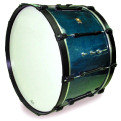 Characteristics of Musical Keys: Composers through history have associated various moods and colours with each of the 24 major and minor keys in Western music. From the link “This document contains a selection of information from the Internet about the emotion or mood associated with musical keys. It is not complete nor does it include information found only in print sources.” There’s even some agreement on a few of the keys. And of course we all accept that D minor is the saddest of all keys.
Characteristics of Musical Keys: Composers through history have associated various moods and colours with each of the 24 major and minor keys in Western music. From the link “This document contains a selection of information from the Internet about the emotion or mood associated with musical keys. It is not complete nor does it include information found only in print sources.” There’s even some agreement on a few of the keys. And of course we all accept that D minor is the saddest of all keys.
…
As I said in my post on understanding the future indie music market, you need to know the minds of your listeners. If you target teenagers, but you’re a few years off yourself, this article could prove enlightening: High School Round Table: A world of music.
Miguel: I think music is a huge influence. That song “Grills” came out. Ten minutes later, everybody had a grill.
Hilary: If you listen to country, you are going to have jeans and a cowboy hat. If you listen to rap, you are going to dress like the girls on the videos.
…
Bob Katz originally wrote The Secrets of Mastering for TC Electronics, and buyers of their Finalizer hardware, but his thoughts aren’t specific to the unit.
Mastering is the art of compromise; knowing what’s possible and impossible, and making decisions about what’s most important in the music. When you work on the bass drum, you’ll affect the bass for sure, sometimes for the better, sometimes worse.
He covers, in more detail than you’d expect from a free article, all the main aspects of mastering: Monitoring, metering, equalization, dynamics, and preparing for radio. I’ve read the paper half a dozen times, and I still learn something from it each time.
Tags: mastering, promotion
 I spend a lot of time, in and out of the studio, with my ears covered, plugged, or otherwise shielded from loud sounds. I do it to protect my hearing, of course, but I wasn’t always as diligent as I am now. The motivation behind my (possible over)use of earplugs was my discovery a few years ago that George Martin retired because of hearing loss.
I spend a lot of time, in and out of the studio, with my ears covered, plugged, or otherwise shielded from loud sounds. I do it to protect my hearing, of course, but I wasn’t always as diligent as I am now. The motivation behind my (possible over)use of earplugs was my discovery a few years ago that George Martin retired because of hearing loss. 
 Double-tracking a vocal is a tried and true technique for adding character to (or covering flaws in) a vocal track. Here are two threads from homerecording.com on doubling vocals: [
Double-tracking a vocal is a tried and true technique for adding character to (or covering flaws in) a vocal track. Here are two threads from homerecording.com on doubling vocals: [ Over the last few months Andrew Dubber, on his site
Over the last few months Andrew Dubber, on his site 
 Generally it’s best to avoid the use of heavy reverb on bass and kick drum tracks, since the extra reverberant low frequencies can quickly lead to a muddy sound. (Remember: Excessive bass causes
Generally it’s best to avoid the use of heavy reverb on bass and kick drum tracks, since the extra reverberant low frequencies can quickly lead to a muddy sound. (Remember: Excessive bass causes  Some instruments, guitars especially, sound great when double-tracked and separated in the stereo image. Hard-panned electric guitars are a standard in modern rock mixes, and engineers have used the technique on acoustic guitars too for decades.
Some instruments, guitars especially, sound great when double-tracked and separated in the stereo image. Hard-panned electric guitars are a standard in modern rock mixes, and engineers have used the technique on acoustic guitars too for decades. 